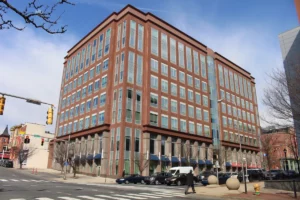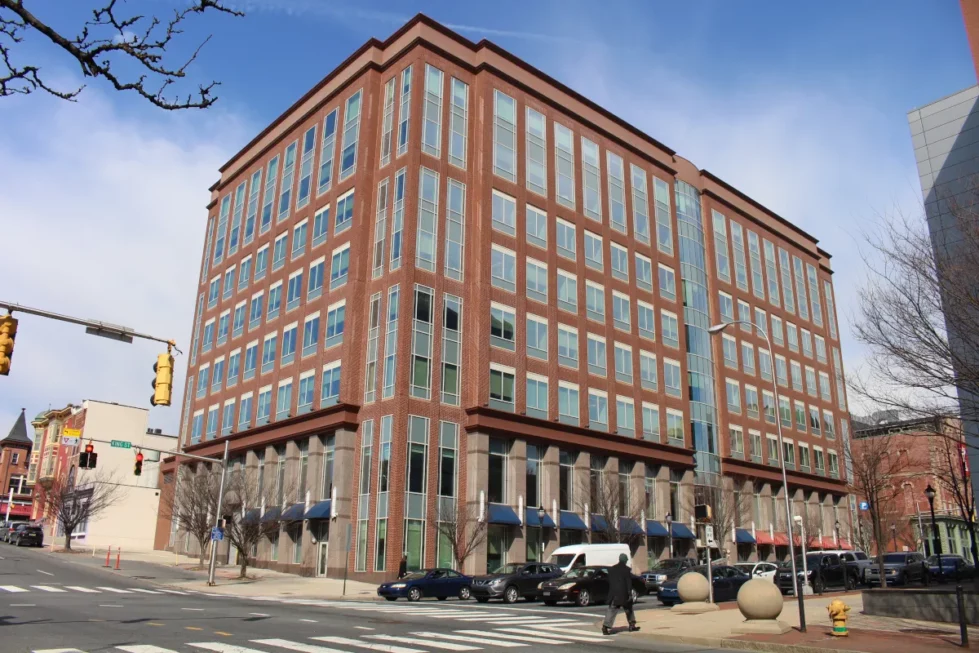
Amtrak bought the Renaissance Centre off King Street in Wilmington three years ago, but a government watchdog has criticized the purchase as unfit for the rail company’s needs. | SPOTLIGHT DELAWARE PHOTO BY JACOB OWENS
In 2022, a government watchdog said a Wilmington office building Amtrak bought for a lofty $41 million was structurally unfit for its intended use, and that the rail company’s goal of saving money by moving hundreds of workers to the site rested on unrealistic assumptions.
In spite of the critique from the Amtrak Office of Inspector General, rail company executives persisted with plans to remake the eight-story Renaissance Centre into a central hub for at least a portion of its dispatch, police and other staff.
Today, Amtrak is on the verge of awarding a contract to retrofit the building for a previously estimated cost to taxpayers of $37 million.
Why Should Delaware Care?
Amtrak is a major employer in the Wilmington area, but its own inspector general also criticized its purchase of the Renaissance Centre, which Amtrak is now investing in further.
As a federally chartered corporation, state and federal taxpayers fund the company while passengers support its operation with fares.
The renovation will involve construction of four “control centers, a data center and office space,” according to a document announcing the bid, which began last summer.
When complete, Amtrak is expected to move 40 dispatchers from outside of Delaware into the Wilmington building, down from the 250 originally planned, according to the inspector general’s report. Amtrak could relocate as many as 35 information technology jobs to the renovated building, down from the initially estimated 400.
 In all, it is the latest chapter of a yearslong murky story that has prompted Amtrak executives to fervently defend their real estate purchase to critics questioning their stewardship of public dollars.
In all, it is the latest chapter of a yearslong murky story that has prompted Amtrak executives to fervently defend their real estate purchase to critics questioning their stewardship of public dollars.
This story began during the onset of the COVID pandemic when the real estate brokerage JLL announced that Amtrak had purchased the Renaissance Center from the Wilmington-based real estate investment firm Commonwealth Group.
Prior to the purchase, the building’s commercial mortgage sat on a creditor’s watchlist, weighed down by too many empty offices.
In its announcement, JLL proudly stated that the sale would eventually fill about 4% of vacant office space in the then-struggling downtown Wilmington real estate market. It didn’t, however, disclose the sale price for the building located at 405 N. King St.
In response, The News Journal filed an open records request to Amtrak for the purchase agreement and related documents. Amtrak responded a year later with the requested records, but redacted every reference to the sale price.
Weeks later, rail company officials changed course and revealed that they spent more $41 million for the building – which was constructed in 2007 with roughly 150,000 square feet of office space and 86,000 square feet of parking.
In late 2018, a nearby, 160,000-square-foot office building that had been recently renovated sold for $12.5 million.
A year after Amtrak revealed the building’s sale price, the Inspector General published its report finding that the company would not accomplish its goal of saving $50 million over time by moving staff from offices across the eastern United States to its new Wilmington office.
It also noted that Amtrak would have to spend an additional $37 million to renovate the building so that it could house dispatch and police staff.
Finally, the report noted that Amtrak still was not certain if it could install an auxiliary generator at the site – a necessity for dispatch and rail police operations.
Amtrak response
On Wednesday, Amtrak spokeswoman Beth Toll provided a statement in response to questions posed about the upcoming renovation. She did not say whether the Renaissance Centre will be able to house a generator, but noted that there will be a “high-reliability” data center at the site.
“Amtrak’s acquisition of the Renaissance Centre fulfills an important facility need in Wilmington, Delaware that will improve Amtrak operations and resiliency. A key use of the building is to create a new Unified Operations Center for our nationwide system there which will drive enhanced reliability, efficiency, safety and customer service,” she said.
The statement echoes those made over the past year by Amtrak executives, including company CEO Stephen Gardner who recently called the Wilmington building a good investment that would deliver value.
ALSO IN THE NEWS: Here’s how Delaware slices its school funding pie
“The building was appropriately sized and scoped for the work that has to happen there,” Gardner said defiantly during Amtrak’s annual meeting in December when questioned by a member of a rail advocacy group about the wisdom of the real estate purchase.
His remarks followed similar ones made by Amtrak Chairman Anthony Coscia during the rail company’s annual meeting the previous year. Coscia stressed that one of Amtrak’s rationales for buying the property was to move its Wilmington staff out of a nearby building that sits next to the Christina River and suffers from frequent flooding.
Coscia further stated that the company’s goal of saving millions of dollars by moving dispatchers, IT personnel, and other staff to Delaware was ultimately “not accomplishable for a series of … legitimate reasons that evolved as we continued the process.”
“None of us have a total crystal ball and we’re all making decisions based on the best available information,” Coscia said at the time.
Still, in its 2022 report, the inspector general said that by late 2019 – six months before its sale would close – Amtrak was told by senior IT officials that relocating most of its planned dispatch and IT staff to Wilmington would not be feasible.
This story first ran on SpotlightDelaware.org, produced by the community-powered, collaborative, nonprofit newsroom covering the First State.
Share this Post




